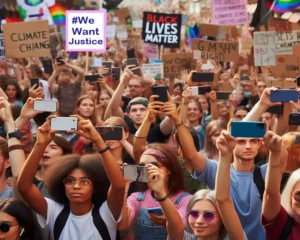Social Media Algorithms and Polarization: A Sociological Analysis
Why does social media feel so divisive? 🤔 Social media algorithms play a powerful—and sometimes polarizing—role in shaping how we see the world.
Dive into the invisible architects reshaping society: algorithms. Unpack the impact of social media algorithms on polarization. This sociological analysis reveals how tech doesn’t just reflect our divisions—it amplifies them by design.
Discover how human connections fray in filter bubbles, why outrage spreads faster than facts, and what rigorous studies say we can do about it. Let’s build bridges, not bubbles.

The Algorithmic Divide: How Social Media Fuels Polarization and What We Can Do About It
Feeling divided? Blame invisible algorithms! Discover how social media feeds fuel polarization and trap us in echo chambers. Learn practical fixes – from tech tweaks to personal habits – to bridge the gap. Let’s heal the digital divide together.
Introduction: The Digital Catalyst Splitting Society
Social media algorithms have transformed from simple content organizers into powerful engines shaping public discourse. These invisible architects of our digital experiences prioritize engagement above all else, creating self-reinforcing echo chambers that amplify division.
Studies reveal that 64% of the global population actively uses social media, spending over two hours daily within these algorithmically curated spaces. This digital immersion comes at a cost: platforms like Facebook and Twitter spread misinformation six times faster than factual content, systematically rewarding outrage and extremism.
The consequences manifest in fractured democracies, violent conflicts, and families divided by alternate realities.
As the World Economic Forum’s 2025 Global Risks Report identifies misinformation as the most critical challenge to societal trust and political cohesion, understanding the algorithmic mechanisms behind polarization becomes urgent.
In this article, we will discuss the impact of social media algorithms on polarization, explore how seemingly neutral code deepens divides, examine the psychological and geopolitical consequences, and chart pathways toward healthier digital ecosystems.
The Engagement Engine: How Algorithms Amplify Division
Social media platforms operate on a simple business model: maximize user attention to sell advertising. Their algorithms achieve this through predictive analytics that identify and promote content triggering strong emotional reactions.
Research shows posts containing words like “hate,” “attack,” and “destroy” receive significantly higher engagement than neutral content, creating a perverse incentive structure. This negativity bias stems from human psychology—we instinctively prioritize potential threats—but algorithms exploit this tendency relentlessly.
The Double Deep Q-Learning techniques used by platforms constantly test which content keeps users scrolling, favoring divisive material that triggers dopamine responses through outrage or validation.
Over time, these systems create personalized filter bubbles where users only encounter perspectives reinforcing their existing beliefs, making opposing viewpoints seem increasingly alien and threatening.
Malicious Manipulation: Weaponizing Algorithms for Discord
Algorithms’ polarization effects aren’t accidental byproducts—they’re actively weaponized.
Concordia University researchers demonstrated how AI-driven adversarial agents could strategically manipulate social networks using hacked accounts. By employing reinforcement learning, these malicious bots identify high-follower accounts positioned to maximize polarization with minimal intervention.
In simulated environments, bots needing only two data points—a user’s current opinion and follower count—successfully amplified vaccine debates into hostile camps.
Real-world parallels include Myanmar, where Facebook’s algorithm amplified anti-Rohingya hate speech, contributing to ethnic violence. Some Zionist people use social media platforms to justify genocide in Gaza and ethnic violence on Palestinians.
Similarly, Philippine authorities used social media to “red-tag” activists, endangering dissenters through algorithmic amplification. These cases reveal how easily algorithms become tools for sowing discord when combined with bad-faith actors.
The Psychology of Extremism: Acrophily and Identity Protection
Human psychology interacts catastrophically with algorithmic curation. Acrophily—the attraction to increasingly extreme viewpoints—explains why users migrate toward content just beyond their current beliefs. This creates a dangerous radicalization treadmill where algorithms constantly push boundaries.
Simultaneously, in-group/out-group bias causes users to trust information from perceived allies while dismissing “out-group” sources, regardless of accuracy.
When community-based fact-checking systems (like Meta’s “Community Notes”) replace neutral arbiters, these biases paralyze consensus-building.
Studies show COVID-19 vaccine notes on X often never appeared because users couldn’t agree across ideological lines.
Political identity further intensifies this dynamic, with partisans defining “truth” to advantage their tribe, making crowdsourced wisdom vulnerable to organized manipulation.
Platform Policy Shifts: The Rise of Unverified Content
Recent platform policy changes exacerbate algorithmic harms. Meta’s 2025 decision to replace third-party fact-checkers with crowdsourced “Community Notes” mirrors Elon Musk’s X model, prioritizing “free expression” over accuracy.
While theoretically democratic, this approach fails against coordinated disinformation campaigns.
Chinese nationalists, for example, manipulated Wikipedia entries on China-Taiwan relations, illustrating how organized groups exploit such systems.
Nobel laureate Maria Ressa warns that replacing professional fact-checkers with community annotation undermines journalistic standards, allowing political agendas to dominate truth verification. These changes reflect platforms’ continued prioritization of engagement—controversial, unreviewed content drives more interaction than nuanced, factual reporting.
Measuring the Divide: Quantifying Algorithmic Polarization
Researchers use innovative methods to quantify algorithmic polarization. Opinion modeling assigns numerical values to user stances (e.g., -10 = extreme left, +10 = extreme right), revealing clustered “echo chambers”.
Graph analysis shows ideologically isolated communities with minimal cross-group connections.
One study of 4 million vaccine-related accounts on X found distinct pro- and anti-vaccine clusters, with algorithms amplifying intra-group consensus while limiting exposure to counterarguments.
Synthetic network simulations further prove how algorithms accelerate division. When 20 synthetic users received algorithmically curated content, polarization increased 47% faster than in neutral information environments. These measurable effects confirm algorithms structurally discourage diverse perspectives.
Table: Key Polarization Amplifiers in Social Media Algorithms
| Amplifier | Mechanism | Real-World Impact |
| Negativity Bias | Prioritizing anger/outrage triggers | Hate speech spreads 6x faster than factual content |
| Acrophily Exploitation | Recommending increasingly extreme content | QAnon/alt-right movements grew via algorithmic recommendations |
| Filter Bubbles | Isolating users in ideological enclaves | 80% of Republicans/Democrats view opponents as “immoral” |
| Adversarial AI | Bots exploiting engagement systems | Vaccine debates polarized using hacked high-follower accounts |
Technological Solutions: Graph Neural Networks as Digital Peacemakers
Emerging technologies offer promising countermeasures. Graph Neural Networks (GNNs) analyze social networks to identify “bridge users” whose moderated stances could reduce system-wide polarization.
Unlike brute-force approaches (e.g., randomly suggesting diverse content), GNNs pinpoint users whose opinion shifts would create cascade effects toward moderation.
In tests using Amazon political book data, GNN interventions reduced polarization 32% faster than traditional methods by strategically moderating just 1.5% of accounts. These systems also combat malicious AI. By simulating bot attacks, researchers train GNNs to detect and neutralize adversarial agents before they amplify divisions.
While not silver bullets, such tools demonstrate how algorithmic design could prioritize social cohesion over mere engagement.
Transparency as Antidote: The Case for Algorithmic Literacy
Legal scholars propose algorithmic transparency as a fundamental right. Haochen Sun’s “Right to Know Social Media Algorithms” argues that algorithmic secrecy undermines democratic participation, public safety, and equality.
Mandating proportionate disclosure—requiring platforms to reveal how recommendation systems prioritize content—could empower users to recognize manipulation. This approach navigates trade secret concerns by balancing corporate interests with public accountability.
Pilot initiatives like France’s Algorithm Audit Law (2024) demonstrate how such transparency works. Platforms must provide regulators and users with simplified “algorithmic nutrition labels” explaining content-sorting principles.
Combined with media literacy education, this helps users contextualize why certain posts appear in their feeds, reducing passive acceptance of algorithmically curated realities.
Youth on the Frontlines: A Generation Shaped by Algorithmic Division
Teens experience algorithmic polarization’s consequences acutely. High school students report physical altercations following social media-fueled disputes, like misinformation about Trans Awareness Week events.
Family relationships fracture along partisan lines, with conservative parents fearing school “litter boxes for furries” (a debunked conspiracy) while progressive teens dread Project 2025’s potential impacts.
Gallup data reveals a troubling paradox. Although moderates outnumber extremists, algorithms amplify the loudest, most radical voices, making centrism invisible. This distortion creates existential anxiety, with minority-identifying youth considering emigration after elections.
Resources like AllSides and Ad Fontes’ Media Bias Chart offer teens tools to recognize algorithmic skew, but systemic change remains essential.
Read More: How Social Media Shapes Youth Mental Health
Global Consequences: When Algorithmic Division Fuels Real Violence
Polarization isn’t merely academic—it catalyzes global conflicts. Facebook’s role in Myanmar’s Rohingya genocide exemplifies worst-case scenarios. Algorithms amplified anti-Muslim hate speech while the company delayed implementing Burmese-language moderation.
Similar dynamics fueled Ethiopia’s civil war and India’s caste violence, where viral misinformation incited real-world attacks.
Geopolitical actors exploit these vulnerabilities, with China manipulating cross-strait narratives and Russia inflaming U.S. election tensions.
The 2025 OIIP Trend Report warns that unchecked algorithmic polarization paralyzes crisis communication, complicating humanitarian responses in conflict zones.
As platforms like Meta abandon fact-checking, risks escalate—particularly in regions with preexisting ethnic or religious tensions.
Breaking the Cycle: Multifaceted Solutions for Digital Reconciliation
Combating algorithmic polarization requires layered interventions:
- User Empowerment: Media literacy programs teaching users to recognize filter bubbles, check sources, and seek diverse perspectives. Tools like Ground News’ “Blind Spot” feature expose users to undercovered viewpoints.
- Algorithmic Accountability: Regulations mandating risk assessments for polarization, similar to the EU’s Digital Services Act’s “systemic risk” provisions.
- Platform Redesign: Shifting engagement metrics from “time spent” to “diversity of exposure.” Twitter’s 2023 “For You” feed experiment temporarily increased cross-ideological reach by 17%.
- Adversarial Preparedness: Using GNNs to simulate and block polarization attacks before they gain traction.
No single solution suffices—a multi-stakeholder approach blending technology, policy, and education offers the best hope.
Table: Comparing Polarization-Reduction Approaches
| Approach | Mechanism | Limitations |
| GNN Optimization | AI identifies key bridge users | Requires platform data access |
| Algorithmic Transparency | Users understand curation systems | Trade secret conflicts |
| Media Literacy Education | Critical consumption skills | Difficult to scale widely |
| Content Moderation | Remove incendiary material | Political bias accusations |
Read Here: The Impact of Social Media on Political Participation
Conclusion: Rewiring the Digital Nervous System
Social media algorithms function as society’s collective nervous system—and currently, they’re transmitting panic signals.
The evidence is overwhelming: from Concordia’s AI-manipulation studies to teen testimonies of school fights, algorithmic design fuels polarization.
Yet solutions exist. Graph Neural Networks could strategically moderate discourse. Transparency laws might demystify content curation, Media literacy empowers users to navigate digital landscapes skeptically.
Implementing these requires rejecting the false choice between engagement and integrity.
Platforms must embed ethical by design principles, prioritizing societal health alongside profit. Users can consciously diversify feeds, pause before sharing outrage-triggering content, and support regulations demanding algorithmic accountability.
The goal isn’t uniform agreement—it’s a digital public square where diverse views coexist without manipulation.
As we stand at this inflection point, our choices will determine whether algorithms continue dividing us or become tools for bridge-building.
Read Also: How Digital media Shapes Public Views on Crime and Deviance





